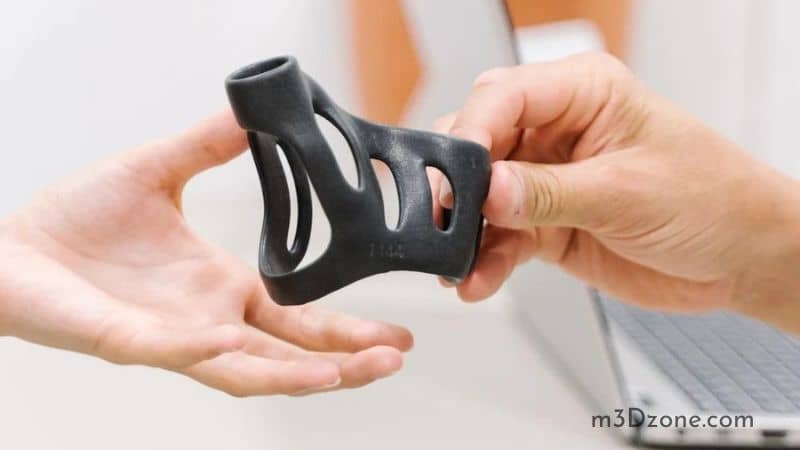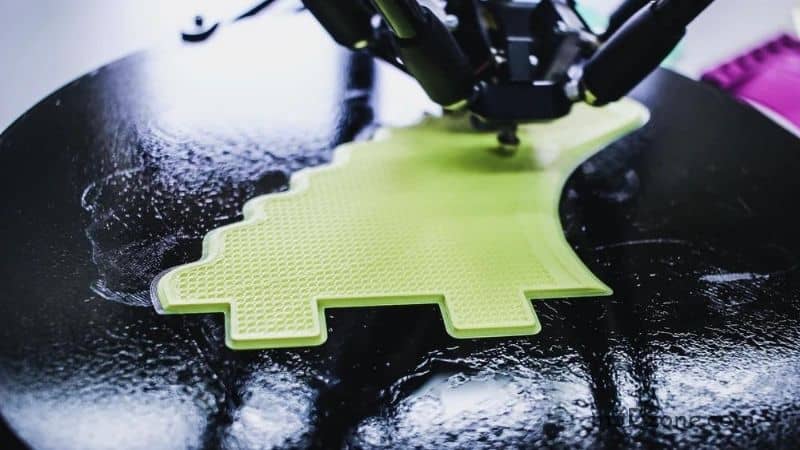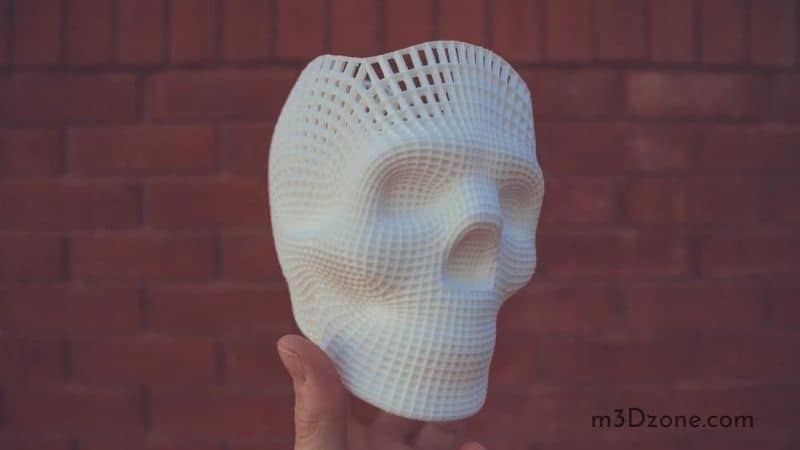Silicone is recently making advancements in 3D printing, not for lack of demand but possesses properties ideal for endless applications. Silicone is highly viscous, accurately affecting 3D printing hence the delay in silicone 3D printing.
Well, the question remains: Can you 3D print silicone? Let’s find out!
![]()
After the solidification process, the silicone object being an elastomer cannot return to a liquid state like thermoplastics and other versatile material.
An elastomer is a polymer that is highly viscous and elastic, in simple terms of rubber. The highlight of rubber property is that it can be stretched and still retain its original form after release. Silicone being a synthetic rubber carries along with several appealing properties as well.
Quick Navigation
Printing Silicone Materials
Silicone filaments had been impossible to print. Silicone possesses excellent thermal stability and biocompatibility, making it a desire in additive manufacturing. The flexibility and idea of 3D printing, silicone offer numerous possibilities in healthcare and other fields.
Unlike other thermoplastics, pure silicone cannot be melted into liquid then re-solidified with the 3D printer technique. Production of silicone materials was solely possible through traditional manufacturing processes like injection molding.
The process is costly for the creation of silicone prototypes and bio models due to expensive molds.
Silicone’s high elasticity makes it hard to infuse other techniques other than injection molding, making it expensive for low volume production.

Several companies are developing novel systems that will incorporate silicone in 3D printing. Novel techniques use head deposition, while others produce parts similar to injection molded parts through photopolymerization.
Silicone 3D printing is more flexible, and unlike the traditional manufacturing process, it is flexible, and the production process is not driven by volume. This allows low volume production of parts produced without the process being so costly.
Liquid silicone has a high viscosity that had slowed down production since it’s different from other polymers. It solidifies at certain temperatures difficult for 3D printers to achieve.
Advancements in the technology of 3D printing and the growing demand for silicone parts have fuelled the development of silicone 3D printing.
Properties of Silicone Parts
Silicone including silicone urethane material is abundant existing and the desired choice for demanding industries, including the textile industry to automobiles. It is widely applicable in spacecraft assemblies, bio-compatible in medical applications, and soft robotics.
The high-performance property enables silicone to have formidable characteristics both physically and chemically.
Formidable properties of silicone include:
- Remarkable thermal stability with the option of raising or lowering the figure
- Water-resistant and repels steam
- Compression and shear resistance makes it suitable for forming tight seals
- Electrical insulation even in water
- Biocompatibility ensures it is food safe
- Color and transparency options make it ideal for optics
- UV and oxidation resistant
- Flame retardant
- Can be sterilized
- Available in different hardness
The properties enable silicone to be dynamic in industries including energy, food production, automobiles, consumer goods, electronics, and even agriculture.
Black boxes in airplanes, sound dampening devices in cars, non-stick wares in the kitchen, and dishwashers are all made of the same material. All the versatility of silicone, propelled engineers and innovators to want to 3D print it.
Additive Manufacturing
Additive manufacturing is also popularly known as 3D printing. It entails creating a 3-dimensional item using digital information instead of tools and silicone molds by progressively adding material layer by layer.

Technologies vary in different forms to pile up the layers but all work on the same principle in creating the final desired object.
How Silicone 3D Printing Works. Can You 3D Print Silicone?
Let’s dive into how silicone works in 3D printing.
1. Deposition
3D printers use print heads to deposit material in 2D shapes, mostly layer by layer. On the other hand, Silicone cannot be available in liquid form, but the process involves deposition too.
Printers deploy a print head that deposits silicone droplets individually, then merges them to form a smooth surface.
2. Curing and vulcanizing
Silicone rubber hat is uncured in liquid or gel form, making it easier to mold release spray during the 3D printing process. Curing is the chemical process through which the printed silicone rubber forms cross-links in the chain, progressively layer after layer.
Some printers use UV light or heat as an alternative for the process. Room temperature vulcanizing silicone reacts with catalysts and other substances hardening in the process.
In the photopolymerization process, the curing stage effectively replaces the deposition stage since it involves beaming the UV light to create a 2D shape for each layer.
3. Post-processing
Vulcanizing allows the printed silicone part to solidify well enough to allow another layer to be printed, and this does not strengthen the whole structure.
After printing, the print may be subjected to the oven, which catalyzes chemical reactions and removes unwanted particles. Washing may also be necessary to remove the support material.

Liquid Additive Manufacturing
It is an extension of additive technique, which involves a highly viscous material like silicone into the build platform to create the expected object, which is then heated to harden it completely. Opportunities for liquid additive manufacturing (LAM) are provided by the functional liquid used to optimize 3D printing.
The materials possess various functions, mainly transparency and flexibility, and can be combined during the printing process. Silicone additive manufacturing ensures the prints exhibit strength after completion.
The functional liquid is first dispensed layer by layer at room temperatures. UV light is used to cure the materials then cross-linked with durometers.
LAM offers an alternative to other 3D printing techniques, including Fused Deposition Modeling and Material Jetting. LAM components and prints are high-performance and well suited for automotive and electronics for fire and other insulation structures.
Liquid additive manufacturing uses high process speeds and guarantees distortion-free prints with limitless freedom as you desire. The method is innovative and rounded for prototypes and small productions. This propels the relevance and application of the process in industries.
Advantages of Additive Manufacturing
-
Affordable costs of entry
The cost of equipment in manufacturing industries and processes is always the obstacle that most companies face. Machinery for additive manufacturing is, however, affordable for most companies and small scale businesses to afford.
With the advancement in innovation and technology, entry costs will be cheaper, cutting entry costs. For small production units, this scales up profits and profitability.
-
Easy to design the end product
Additive manufacturing is more than just getting your printed print. It involves design and innovation at its best level. As a creative, one can have the freedom without time and costs when it comes to additive manufacturing.
Traditionally, modification of the print led to a spike in costs and time delays after the production line is altered. Engineers can produce several versions of a single design, cost-effectively away from static methods using additive manufacturing.
-
Training programs available at all levels
Getting the machinery and equipment is one thing; having the skills and workforce to run and operate the equipment efficiently is another thing. Training your staff and workers to design using additive manufacturing professionally is most likely to delay business operations.
However, there are various training programs for designers and manufacturers available at different levels. Fundamental training is for staff who have had experience in technology.
Technical training targets to educate decision-makers on maximizing properly, while advanced training is mainly for post-production and material handling.
-
Reduces wastes during production
Additive manufacturing principle’s in the production processes and differs greatly from traditional manufacturing methods. Some machines work by removing material from a bigger block than the intended product.
The cut-off materials in the form of shavings and cannot be used therefore end up as waste. Additive manufacturing, however, works by adding materials layer by layer such that only what is needed is used. Additive manufacturing helps reduce material costs by as much as 90%.
-
Energy saving
Additive manufacturing significantly reduces energy usage since it reduces the material to use and cuts off the steps in the production process as compared to traditional manufacturing processes.
Re-manufacturing parts aided by additive manufacturing revives the end of life of products to new conditions using energy ranging from 2-25 % of the energy that would otherwise require to build a whole new part.
3D Printed Silicone Setbacks
-
Hardware and material availability
3D silicone’s main limitation is its access. Several companies offer legit silicone 3D prints; this means costs are spiked, and there’s a limited choice of material.
-
Structural limitation
3D printing companies have been sprouting over the years, but the production material is still not additive friendly. The structural silicone 3D printer has one head, meaning it will only create simple objects with little detail.
Printers that use stereolithography-based technologies evade the problem, but still, the resins include UV curing. The best silicone 3D printers have relatively small build areas that cannot print support structures for the print.
-
The need for curing agents
Close to no companies can 3D print pure silicone in their production processes. Most of them invoke the use of UV curing agents; this tends to weaken the material and reduce the quality of the finished product.
However, this still maintains positive properties even after silicone molding and is available for a wide range of applications.
Conclusion
There’s still a long way to go for silicone 3D printing. With the slow development growth rate of technology, the adoption rate is relatively lower. Most companies are ignorant and are unaware of what the technology has to offer or are hesitant to adopt it since it’s not commonly used.
With the ongoing developments and improvements of new companies moving into silicone 3D printing, it remains a viable alternative to silicone manufacturers’ industries.
The demand for silicone 3D printed parts and silicone mold is steadily rising and hints at the future technology being an exciting one.
Recommended Reading
Educational 3D Printing. 3D Printers in Education.
In short educational 3D printing refers to using the new technologies in 3D printing explicitly designed to help students learn. Let's find out how!
3D Printing Molds for Casting [Step by Step Tutorial]
3D printing molds for casting is rising in popularity in the 3D printing industry. It helps you to acquire various 3D printed products. Let's see how it's done!
Optimal ABS Filament Temperature for Your 3D Prints
What is the optimal ABS filament temperature? ABS has a relatively low melting point so that it can be printed at lower temperatures than other materials.
